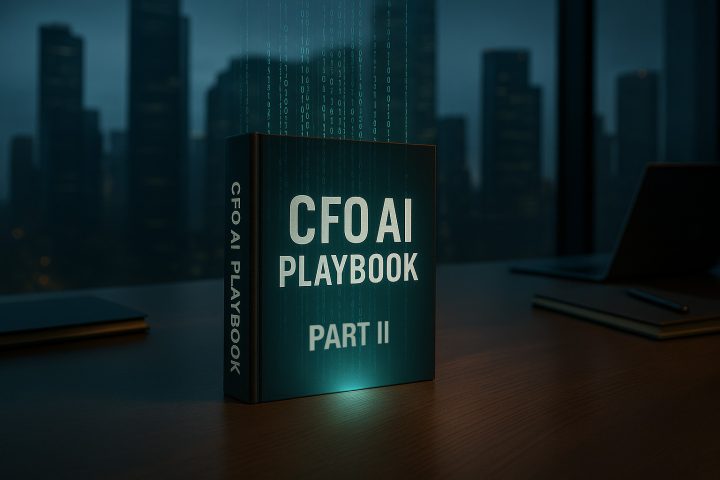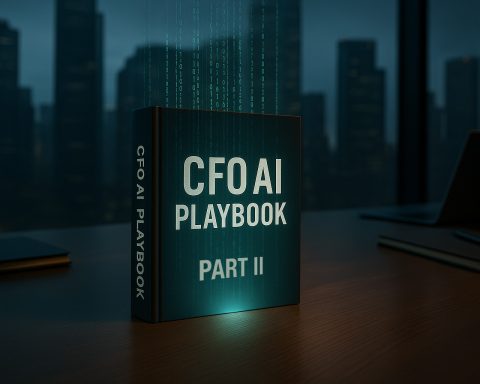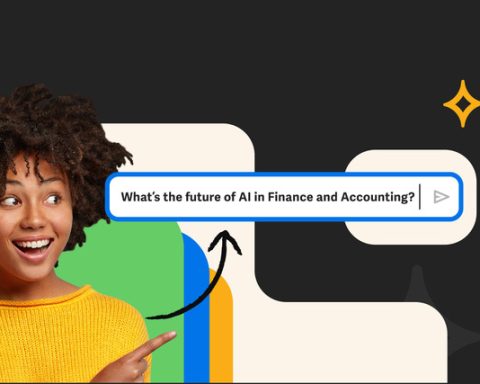Introduction
Artificial Intelligence (AI) has come a long way from back-office automation. Far surpassing number crunching, it actively shapes strategy, influences boardrooms, and helps financial executives lead with insight, speed, and foresight. After sharing AI’s top finance use cases (and why enterprises fail) -Where do we go from here?
That question is exactly what this article is about.
Whether you’re a CFO, VP of Finance, or strategic advisor, this is the moment to look beyond incremental improvement and automation. Think in terms of innovation through AI transformation. This means new ways of making decisions, redefining risk, and recalibrating the value of both human and machine intelligence.
Let’s break it down.
What’s Working Today
1. Automated Financial Reporting and Summarization
The average finance team still spends 30–40% of its time manually preparing reports, consolidating data, and drafting commentary. For all our cloud ERPs, shared drives, and collaboration tools, reporting remains the anchor slowing down strategic momentum. The pain point is universal: too much time spent reporting the past, and not enough spent shaping the future. As a result, automated financial summarization is one of the most impactful, underutilized AI use cases today.
Let’s be clear. This is not about AI bots copy-pasting Excel into Word. This is about AI models that understand financial data contextually, generate tailored narratives for different stakeholders, and adapt tone, emphasis, and focus based on the audience. Think of it as having a virtual financial analyst who writes (and rewrites) your monthly reporting packs, board books, investor updates, and performance commentaries at scale and on demand.
Consider a regional bank with $10B+ in assets. They had a lean FP&A team stretched thin with regulatory reports, investor decks, and executive summaries. We implemented a custom LLM-based summarization layer on top of their general ledger and BI platform using GPT-4 Turbo with Retrieval Augmented Generation (RAG). The result? Within seconds, the AI generated:
- A tailored board report summarizing key movements in revenue, net interest margin, and risk-weighted assets with suggested talking points for the CEO.
- A simplified customer-facing financial brief to support their ESG transparency initiatives.
- A visual summary with auto-generated charts for internal strategic meetings.
How much time was saved? Nearly 180 hours per quarter. However, the bigger win was the increased clarity and consistency in how financials were communicated across the organization.
And the impact is being felt across industries.
- Mastercard is using natural language generation (NLG) to auto-create audit reports and internal performance reviews.
- PwC launched its own generative AI assistant that drafts portions of client financial reports with context-aware insights, reducing errors and formatting time.
- Even mid-sized private equity firms are embedding tools like Narrative Science Quill (now part of Salesforce) to turn dashboards into decision-ready commentary.
The key is this: AI doesn’t just summarize numbers… it tells the story behind them.
For example, instead of “Revenue rose 8% in Q2,” the AI writes:
“Revenue growth of 8% in Q2 was primarily driven by a 12% increase in EMEA software subscriptions, offsetting a 4% decline in North American hardware sales. Customer churn improved by 1.3 percentage points, boosting recurring revenue and improving gross margins by 70bps.”
That’s insight… generated in seconds, allowing finance leaders to quickly iterate for different audiences: the board, the CEO, business unit heads, even regulators.
So, what’s the opportunity? Free up your smartest people to focus on the “why” and the “what next,” not formatting the “what happened.”
AI automated summarization saves time. It also improves accuracy, enforces consistency, and scales thought leadership across the organization. Whether you’re consolidating subsidiary performance or preparing investor-ready ESG disclosures, AI can reduce the manual burden and increase your strategic bandwidth.
Thankfully, getting started isn’t difficult. Most platforms enterprises already use (e.g. Power BI, Workiva, Tableau, Salesforce) now support natural language generation plug-ins or APIs. You don’t need to build a custom model. You need the right integration and a clear use case.
2. Predictive Budgeting and Forecasting
The budgeting process is undergoing a substantial change. Traditionally, financial executives relied on a patchwork of historical data, Excel wizardry, and institutional memory to build annual plans. That model worked when markets were stable and operating environments were predictable. However, in today’s world marked by volatile interest rates, rapid supply chain swings, and shifting consumer behavior, static budgets are liabilities, not assets. This is where AI predictive budgeting becomes indispensable.
At its core, predictive forecasting leverages machine learning algorithms trained on years of financial, operational, and external data (e.g. macro trends, customer transactions, weather patterns, geopolitical events) to generate models that reflect current realities but also dynamically update as conditions change. We’re moving from rearview mirror accounting to GPS-level navigation for finance.
For example, a large industrial supplier faced wild demand fluctuations in 2023 due to post-COVID infrastructure funding and material shortages. Their traditional quarterly budgeting cycle left them blind to sudden market shifts. As a result, they implemented a rolling forecast system using Amazon Forecast and Alteryx, ingesting historical P&L data, logistics feeds, and even public bid announcements. The system recalibrated forecasts weekly. Not only did they reduce forecast variance by 35%, but they also optimized inventory purchases, saving $6+ million in overstock risk in their first quarter of use. The CFO told me bluntly, “This was the first time we felt like we were driving the business rather than reacting to it.”
And they’re not alone. Financial leaders at Coca-Cola, Unilever, and Procter & Gamble have gone public about using AI and digital twins to simulate how currency swings, marketing campaigns, or raw material price shifts might impact their forecasts. In fact, Unilever’s CFO Graeme Pitkethly noted in a recent earnings call that predictive forecasting now underpins everything from working capital decisions to capital expenditure planning.
What’s exciting (and urgent) is this technology isn’t reserved for Fortune 100 firms anymore. Mid-market companies are already adopting platforms like Pigment, Planful, and OneStream, often layering in open-source ML models (like Prophet or XGBoost) to build out capabilities without blowing up budgets. Even Google Sheets has AI plug-ins that can support scenario modeling.
Furthermore, here’s the real opportunity: while AI improves the accuracy of your forecasts, the true benefit is that it transforms the way you plan.
Rather than holding one master budget hostage to endless consensus meetings, finance leaders can present the C-suite with multiple AI generated scenarios:
- What if we accelerate our hiring plan by two months?
- What if a key supplier in Vietnam shuts down?
- What if FX rates move 3% against the Euro?
AI can simulate the downstream impacts instantly and highlight risks and levers. Imagine seeing decision ripple effects on gross margin, EBITDA, and cash burn as part of analyzing thousands of scenarios. As a result, I’ve seen clients move from a 3-week budget iteration cycle to 3 hours. Think about that. Three hours to assess and make complex business decisions with data-backed clarity.
Consequently, if you’re still building static budgets in disconnected spreadsheets, you’re lagging. Worse, you’re leaking value. Enterprises that use predictive AI budgeting gain real-time agility, strategic foresight, and execution confidence. Moreover, when finance leads the AI charge in budgeting, you elevate your seat at the strategy table.
3. Risk Management and Fraud Detection
Risk is a 24/7 battlefield, and AI is quickly becoming the CFO’s most valuable weapon in that fight. With escalating cyber threats, increasingly sophisticated fraud tactics, and tightening regulations, traditional rule-based controls simply can’t keep up. They’re rigid, easy to bypass, and reactive at best. That’s why financial leaders across industries are turning to AI risk detection systems which learn, adapt, and flag anomalies in real time.
Consider the CFO of a national logistics firm, who came to me frustrated by recurring expense report abuse that somehow slipped through their ERP and audit teams. We deployed an AI anomaly detection model built on historical spend data, vendor records, employee behavior patterns, and even geolocation metadata from submitted receipts. Within the first 10 days, it flagged seven instances of duplicate reimbursement attempts, including two tied to ghost vendors funneling kickbacks. The result? A complete overhaul of their T&E process and over $2 million in fraud exposure prevented.
Sadly, this isn’t an isolated case. Mastercard’s Decision Intelligence platform uses machine learning to assess the fraud risk of every transaction across 200+ data points (e.g. device fingerprints, behavioral biometrics, and contextual merchant data.) It processes over 75 billion transactions annually, with AI models that reduce false positives while catching increasingly subtle fraud attempts. That’s the scale and intelligence we’re talking about.
Meanwhile, JPMorgan Chase has invested heavily in AI risk analytics to monitor trading behavior and financial controls. In 2024, they disclosed that their AI monitoring systems flagged a rogue algorithmic trade within milliseconds (something their traditional controls would have missed until post-close.)
So, what’s changed? Today’s AI systems don’t wait for predefined thresholds. They build profiles, track patterns, and detect deviations dynamically to flag issues a human wouldn’t even think to look for. And it’s not just about financial fraud. AI is also flagging insider threats, cyberattack precursors, and regulatory exposure in complex vendor ecosystems.
Recently, a mid-sized healthcare company integrated Darktrace’s enterprise immune system AI, which monitors internal financial systems for suspicious behaviors. Within three weeks, it identified a legacy FTP process uploading large financial files after business hours. A benign process gone rogue due to a forgotten credential. While it appeared to be a small matter, it could have become a serious data leak.
Thus, the opportunity and benefits are massive and twofold:
- Real-time visibility into operational and financial risk, powered by systems that don’t sleep or take shortcuts.
- Proactive fraud deterrence, by using AI to close the gaps your human controls can’t see.
Let’s be real. Bad actors are already using AI to exploit loopholes. The question is: are you using AI to stop them?
Thankfully, there’s a lot of work done in this space and the market offers scalable, finance-friendly tools like AppZen (for AI spend compliance), Unit21 (for fraud detection in payments), and even custom ML models built on Snowflake or Azure Synapse that can flag irregular ledger activity at a fraction of the time and cost of traditional audits.
However, here’s the part no one tells you: You don’t need a massive AI team to get started. What you need is a clear problem, the right data, and an expert who can help you connect the dots. That’s how even small businesses have reaped the benefits of AI as a risk advisor.
4. Compliance and Regulatory Reporting
Compliance is a full-time job for financial executives. Between evolving tax laws, international data regulations, ESG disclosures, and industry-specific mandates, staying compliant is like trying to hit a moving target in a hurricane. And the cost of missing? Fines, lost credibility, and shareholder fallout.
But here’s the good news: AI is starting to level the playing field.
In the past, compliance was largely reactive. You waited for new rules, scrambled to interpret them, updated policies, and hoped your audit trail would hold up. That manual, check-the-box approach is inefficient and has proven to be unsustainable. The current regulatory environment demands real-time adaptability and proactive insight. And that’s exactly what AI delivers.
Let’s look at a multinational consumer goods company I helped. They faced significant challenges navigating multi-jurisdictional tax reporting. They were tracking over 300 regulatory frameworks, manually interpreting legislative updates across 40 countries, and trying to map them to their internal controls. It was a nightmare. However, we integrated an AI solution that automatically ingests regulatory changes and maps obligations to a company’s specific risk profile. What once took their legal and finance teams four weeks now takes under 12 hours, and it comes with documentation, rule logic, and alerts built in. Even better, the CFO no longer waits for compliance reports. The system pushes real-time risk flags when a new rule in, say, Singapore’s corporate tax regime affects their intercompany transfer pricing. Now, that’s a strategic advantage.
Likewise, let’s consider ESG. With the EU’s CSRD (Corporate Sustainability Reporting Directive) rolling out in stages and U.S. SEC climate disclosure rules looming, companies must prepare for ESG data to be treated like financial data. That means the same rigor, traceability, and audit-readiness. That’s why companies like Watershed, Persefoni, and Greenomy are embedding AI into carbon accounting, sustainability performance tracking, and automated reporting. These platforms use machine learning to map emissions across Scope 1, 2, and 3 categories, allocate them to business units, and generate ready-to-file reports aligned to SASB, TCFD, and GRI standards.
To illustrate the deep concern by financial executives, one FENG member said it best to me: “I don’t want to be the CFO that missed a regulatory disclosure deadline because of a broken spreadsheet.”
So, here’s the opportunity: You don’t have to be overwhelmed by compliance complexity. You can turn it into a differentiator. AI transforms compliance from a bottleneck into a strategic capability. With the right tools, your team can:
- Monitor global rule changes in real time.
- Proactively align reporting to evolving standards.
- Build a fully auditable, explainable trail without tripling headcount.
Moreover, you don’t have to rebuild your tech stack. Many AI compliance tools plug into existing ERP and finance systems. You can start with a pilot in one region or function, prove the ROI, and scale from there.
What I always tell clients is this: If compliance is eating more of your time and resources, AI is your lifeline. It gives you back control, visibility, and the ability to act, not react.
5. Strategic Decision Support
AI can be an amazing strategic advisor because it can see around corners, spot buried trends and deliver insights that give finance leaders a competitive edge. Let me be blunt: if you’re still relying solely on BI dashboards and lagging indicators to make high-stakes decisions, you’re already behind. Today’s best-performing organizations tap AI to answer questions but, more importantly, to surface the questions they should be asking.
Take a Fortune 100 manufacturing company I recently advised. Their executive team was struggling with how to respond to volatile raw material costs and shifting demand across Asia-Pacific markets. Instead of running endless spreadsheet models, we created an AI decision intelligence platform which integrated pricing data, supplier reliability metrics, market sentiment from news feeds, and predictive demand curves.
Within hours, the system generated three optimal sourcing strategies, each aligned to specific risk and margin thresholds. It also recommended which suppliers to negotiate with based on historical pricing trends and freight lead times. The CEO called it “the closest thing to a crystal ball I’ve ever seen.”
That’s strategic decision support in action, and it’s already in use. Look at the current tools available. Salesforce’s Einstein, ThoughtSpot Sage, and Google’s Looker with Vertex AI now embed GenAI and machine learning into financial dashboards, surfacing revenue drivers, churn risks, and margin leakages. While these tools give you charts, they also tell you why something is happening and what actions you can take.
Even mid-market companies are adopting decision intelligence layers over their ERP and CRM systems. One financial executive used AI to analyze customer renewal behavior, billing history, and product usage data. The AI flagged a 26% probability that a major client would churn in a few months. Acting early helped them renew at higher margins and restructure the account for growth.
We are entering a new phase of executive decision-making, where AI augments human judgment with precision, speed, and objectivity. The best finance leaders are now co-piloting with AI, asking:
- “What’s the financial risk of delaying this product launch by 60 days?”
- “How will a 0.5% interest rate hike impact customer acquisition in EMEA?”
- “Which levers can I pull right now to protect EBITDA if demand drops 10% next quarter?”
Thankfully, AI can help answer those questions by drawing from thousands of data points you don’t have time to manually synthesize. However, here’s the kicker: strategic decision support doesn’t require you to overhaul your business systems. You can start by plugging AI into your existing decision-making cycles (i.e., FP&A, pricing reviews, investment committee prep.) You don’t need a battalion of data scientists. You need the right use case, good data hygiene, and a roadmap for testing, validating, and scaling.
This opportunity is enormous. You already have the financial expertise. When you pair that with AI’s pattern recognition and simulation power, you become more than a CFO or controller. You become a real-time strategist, one who sees not just what’s happening, but what’s coming next and how to respond before competitors even know what hit them.
Keep this in mind. Strategy is no longer just vision… it’s velocity. And AI is how you accelerate.
Conclusion
AI is fundamentally reshaping the role of the Chief Financial Officer by automating and summarizing financial reporting, improving strategic decision-making, driving deeper financial insights and mitigating risk.
With AI’s ability to analyze vast amounts of data in real time, CFOs can shift their focus from historical reporting to forward-looking, data-driven strategies. However, the integration of AI also requires CFOs to navigate challenges around data quality, ethics, and change management.
The future will likely see a more integrated and collaborative CFO function, where technology and human insight work together to unlock new opportunities and mitigate risks. Ultimately, AI is not just enhancing the CFO’s playbook; it is transforming the entire financial landscape.






















